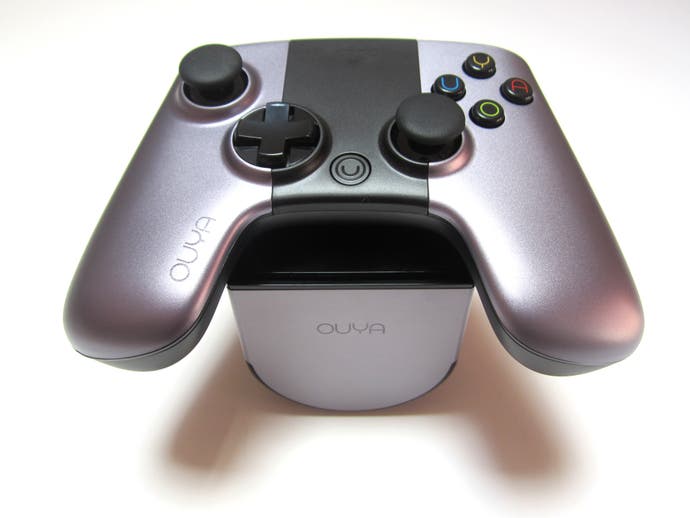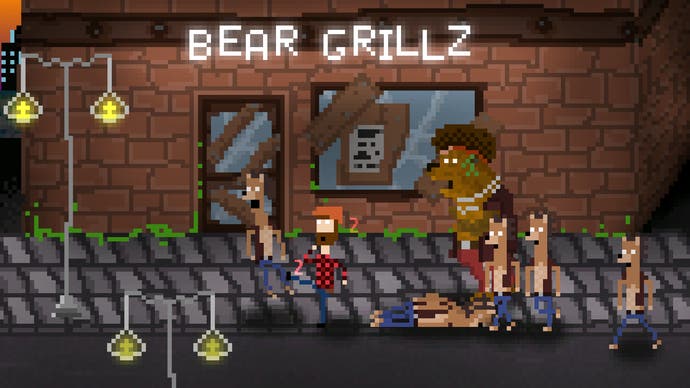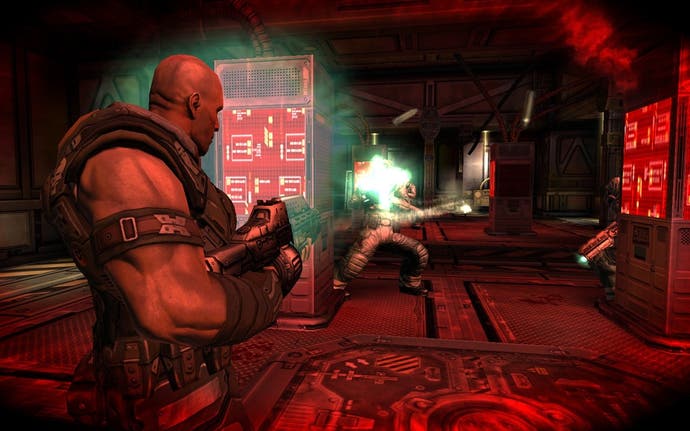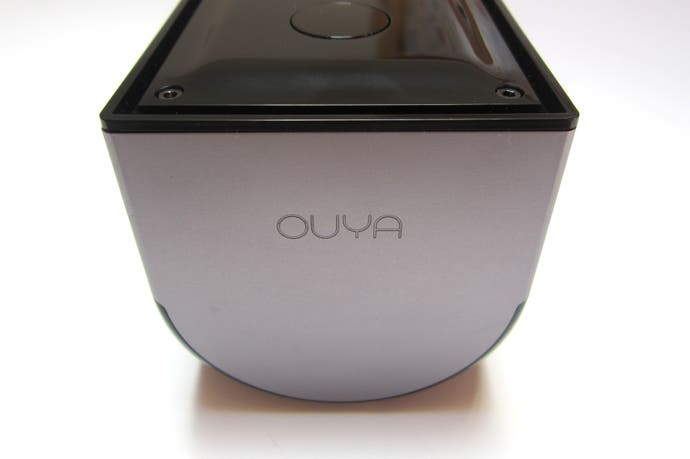Ouya or ou-nah?
On its UK launch, how does the Android console sit in a real-world living room?

If we could live off goodwill alone, then Ouya would already be considered a success. With its dream of an open source console that everyone can afford and anyone can publish for, it tapped into something powerful.
Over a long and often fractious console generation, gamers and developers alike have grown disillusioned with the way the industry works. Glossy sequels failed to transform their bloated budgets into fresh ideas. Publishers clutched at straws in the battle against used sales, poking innocent gamers in eye as they went. Surely there was a better way to do it? A way that both captured the "anything goes" ethos of the Good Old Days while making the best of the digital on-demand culture of today.
Ouya, along with several other Android-powered micro-consoles, has undoubtedly released in the right place at the right time, but is it the right product?
We've already taken a detailed look at the Ouya in Digital Foundry's review, but now that it's on sale to the general public in the UK - sitting alongside Xboxes, PlayStations and iPads on mainstream shopping sites - what is the average consumer going to expect when they click that "Add to basket" button? More to the point, will they be happy with what they get?
This, after all, is the audience that Ouya has to win over. That impressive $8.5m Kickstarter haul will have smoothed the console's journey into production, but there's also the danger that it has front-loaded the launch; the indie game devotees, along with the hardcore hobbyists and tinkerers who will jump on any hackable piece of kit, have already spent their money. Now Ouya has to impress everyone else.
First impressions are likely to be reasonably good. The console itself is compact but weighty, with a tasty brushed aluminium finish and an eye-catching design. While the price may be low, that's not reflected in the tactile qualities of the unit. It's easy to connect up as well. Power lead in, HDMI out, and it's ready to go.

The controller isn't quite as successful. It feels substantial and avoids the plasticky feeling that budget joypads often have, but it's a bit of an ergonomic nightmare for anyone with small hands. In both size and weight it's a lot like the original Xbox controller, but with ends that flare out rather than tapering in. It fit into my enormous meat-shovels without a problem, but my kids struggled to wield it comfortably for any length of time.
Early problems with controller lag and sticky inputs have been addressed, but not eradicated. Both the d-pad and face buttons require a fraction more pressure than we're used to, a small variable that nevertheless feels very noticeable in certain games. The touchpad that sits at top centre of the controller is a clumsy thing, and it's entirely likely that many users will never even know it's there - there's certainly nothing in the brief manual or set-up instructions to show it off.
The console's minimalist set-up also leads to some curious confusions. The Ouya controller can only be paired with the console when it's set to a specific set-up screen, and it often needs to be re-paired for no apparent reason. I found that after one lengthy system update, I had to pair the controller again, except I couldn't get to the pairing screen because the console was waiting for me to hit an "OK" prompt but the controller, obviously, wasn't connecting. After several minutes without connecting the console defaulted to the pairing screen, but I only found that out by heading to the internet for advice.
Finding new games on the store is better than it was since the introduction of a search function, but there's still a lucky-dip feel to the way games are showcased
It's sometimes an inelegant system then, but that's to be expected for a product barely out of the R&D womb. That "almost but not quite" approach extends to the menus and the storefront, which have a crisp and appealing design but muddled content within.

Finding new games on the store is better than it was since the introduction of a search function, but there's still a lucky-dip feel to the way games are showcased. Despite apparently having over 170 games to choose from, the same handful are still hogging multiple slots on the storefront. Getting other developers to spotlight their favourites is a good idea, but the rudimentary "like" system for voting up the good stuff is a blunt tool when more nuanced selection is required.
Downloading the games - which is probably rather important - is also problematic. It's common to start several downloads, only for some of them to simply fail without explanation or warning. A recent update has introduced a download queue, but this is an opaque thing - there's no apparent way to see the queue, or to cancel games that are on it. Instead, you have to scroll all over the store front, looking for the red progress bars that signify titles you're currently downloading. Given that the same game can appear multiple times on the same page, it all becomes a bit of a mess.
And while we're moaning about the shop, there's still no indication of how much a game costs - or what and when you're expected to pay - at the point of download. That's down to Ouya's policy of mandatory free trials, which is admirable, but it needs to be balanced out by requiring developers to be up front with what's on offer. When you do make a payment, prices are still in dollars rather than localised currency. With its proliferation of hand-drawn product tiles and free-for-all tone, there's a scrappiness that is endearing to an old 8-bit lag like myself who remembers flicking through racks of pocket-money games all Saturday afternoon - but for a wider audience, it has a jumble sale feel that is unlikely to encourage long-term commitment.
It's a pity, since there are some real gems to be found once you start digging; Eurogamer reviews of the best titles will appear next week. But it seems ridiculous that a console which relies completely on digital sales has such a poorly featured marketplace through which to do business. Browsing the games on offer feels a lot like wading through the Xbox Live Indie Games channel, with a morass of barely competent amateur efforts threatening to swamp the handful of truly great titles.

It's here that Ouya's still-evolving firmware feels most behind the curve. The App Store has a similar problem with visibility, but it also has a vast and engaged user base that allows word of mouth to sort the wheat from the chaff. Apple's own stringent rules, while stifling in some respects, at least mean that the App Store front page is constantly refreshed and customers know what they're getting.
With no social features (those are on the way, apparently) and no browser alternative for its store, Ouya is going to struggle to drive people to its best content. If you find a good game, the best you can do is tell your fellow Ouya-owning friends what it's called so they can search for it. You can't link to it on Facebook, tweet about some grass roots hit, or queue up a download at work or on your phone.
It all adds up to a console that is better in theory than it is in practice - but not by much. There have been multiple system updates in the last few weeks, each of which inches the console closer to, if not perfection, then at least something that can be recommended without caveats.
For now, however, the caveats remain. For every moment of delight that Ouya serves up from the murky stew that is its marketplace, there are a dozen annoyances of varying degrees of severity. It requires a lot of patience and forgiveness, an investment in what it's trying to do, in order to see this device as a long-term investment.

Whatever Steam, Xbox Live Arcade and the App Store have that makes them work - structure, variety, polish - Ouya doesn't have it. Not yet
A hundred quid for a console sounds like a bargain until you remember that you can pick up a basic Xbox 360 for not much more than that. A brand new Wii costs £89 on Amazon right now. The GameStick will be along soon, offering much the same benefits in a portable format. And that's without factoring in the powerful gaming machines people are already carrying around in their pockets and bags, many of them now running more advanced versions of the same codebase as the Ouya.
This isn't to denigrate what Ouya is attempting, but it's fair to say that the market for this machine feels incredibly niche, and the prospect of crossover into the mass market seems like wishful thinking. There's something here, but whether it's enough to hang an entire hardware company on remains to be seen. I've shown the Ouya to various casual gaming friends and family members, and all have been impressed and intrigued - right up to the point where they start browsing for games. Whatever Steam, Xbox Live Arcade and the App Store have that makes them work - structure, variety, polish - Ouya doesn't have it. At least, not yet.
Some more robust exclusive games would certainly help, as would a tweaked controller and an overhauled storefront. Most of Ouya's missteps are silly little things, speed bumps in the usability of the device that are so easily fixed they should have been weeded out before the device went on sale. That speaks highly of the console's flexibility, but leaves a worrying question mark over the testing process behind it.
Taken as an inexpensive toy for tech enthusiasts and other people who know what "side loading" is, Ouya is cute and commendable. Sadly, much like the similarly idealistic GP32 handheld, it seems destined to end up as a bespoke emulator in the living room of die-hard retro gamers, rather than a viable contender in the console space.

